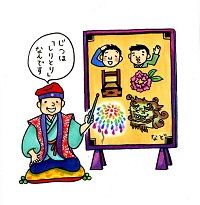Hakata Culture vol.5
The Origins of the Dontaku Song

One of the most exciting carnivals in Japan, Hakata Donkatu, has its own theme song called “Bonchikawaiya.” Where exactly did it come from and who discovered this tune? It's said to have originally been part of "Shiritori", a traditional word game popular during the Edo Period (1603-1867).
A figure who played an important role in the tale of the Dontaku song is Kawaharada Heibei, a Hakata merchant who lived in the middle of the Meiji Period (1868-1912). He was the third son of the owner of a stationery shop, "Heisukefude Fukodo", with roots in the early 16th century (this store still exists today). Because he was not obliged to take over his parents' business, Heibei moved to Tokyo to receive training at the sweet shop “Eitaro Amehonpo.” Upon completion, he returned to Hakata and opened his own confectionary shop, "Eishodo", inspired by the lyrics of the Hakata Yamakasa Festival chant 'Eishoe, Eishoe.' He obviously loved Yamakasa very much and was fond of puns and matsuri! Even during his years in Tokyo he used to assemble Hakata people - who called themselves 'Chikushi Folks' (Chikushi was a place in Fukuoka at that time) - to join in the celebrations of several festivals in Tokyo, Kanda and Shiba.
His passion for festivals continued and Heibei asked the successor of his father's stationery store to sponsor the establishment of Kyushu’s first brass band club. This club later participated in Hakata Dontaku, laden with trumpets, drums and gold-buttoned outfits. They performed the same song that Heibei had become familiar with when playing "Shiritori" during his Tokyo days, but he reworked the tune to better suit it to Hakata culture. Up to this day, it remains the trademark of the Dontaku festivities. So why don't you learn and practize this song too and join the festival with flare!
Kimiyo Sasaki
♪ぼんちかわいやねんねしな
博多どんたくのテーマソング「ぼんちかわいや」は、もともとは江戸のしりとり唄と言われています。江戸・嘉永年間の絵草紙(絵入り本、錦絵といわれる浮世絵もこの一つ)に「五郎、十郎、曾我兄弟、きょうだい、長持ち、たばこ盆、ぼんやはよい子じゃ、ねんねしな、品川女郎衆は十匁(しながわじょろうしゅはじゅうもんめ)十匁の鉄砲玉、玉屋は花火の大先祖」とあったようです。
この江戸のしりとり唄を博多風にアレンジしたのが、明治時代の博多商人・河原田平兵衛(かわはらだへいべい)さんです。河原田さんは1501年から今でも続く文具屋さん「平助筆・復古堂(へいすけふで・ふっこどう)」の三男坊として生まれた、明治中頃の人です。文具屋を継ぐ必要もなかったので、東京の「榮太郎飴本舗(えいたろうあめほんぽ)」というお菓子屋で修行をし、博多下呉服町で「榮松堂(えいしょうどう)」を開きました。この店名は博多祗園山笠で歌われる「博多祝い歌」の歌詞「エイショーエ、エイショーエ」をもじったもの。平兵衛さん、よほどオヤジギャグが好きだったとみえます。祭り好きで、修行中も東京・神田や芝の祭礼には東京に住む博多出身者を集めて「筑紫連中」と名乗り飛び入り参加していたとか。
平兵衛さん、音楽が得意のうえにハイカラで、明治20年代には、文具屋を継いだ平助さんにスポンサーになってもらい、博多で最初のブラスバンドをつくり、博多どんたくのパレードにも参加し、市民の人気をさらったようです。金ボタン付きの洋服を着て太鼓にラッパを打ち鳴らしました。商用で何度も東京に行くうちに江戸のしりとり唄を持ち帰り博多風にアレンジしたのです。曲はこれまた吉原で女性たちが三味線で演奏していた「騒ぎ」という曲を編曲したようです。「ぼんちかわいやねんえしな、品川女郎衆は十匁、十匁の鉄砲玉、玉屋がかわい、スッポンポン」。この歌をマスターして博多どんたくにGO!
福岡市広報課長 佐々木 喜美代

